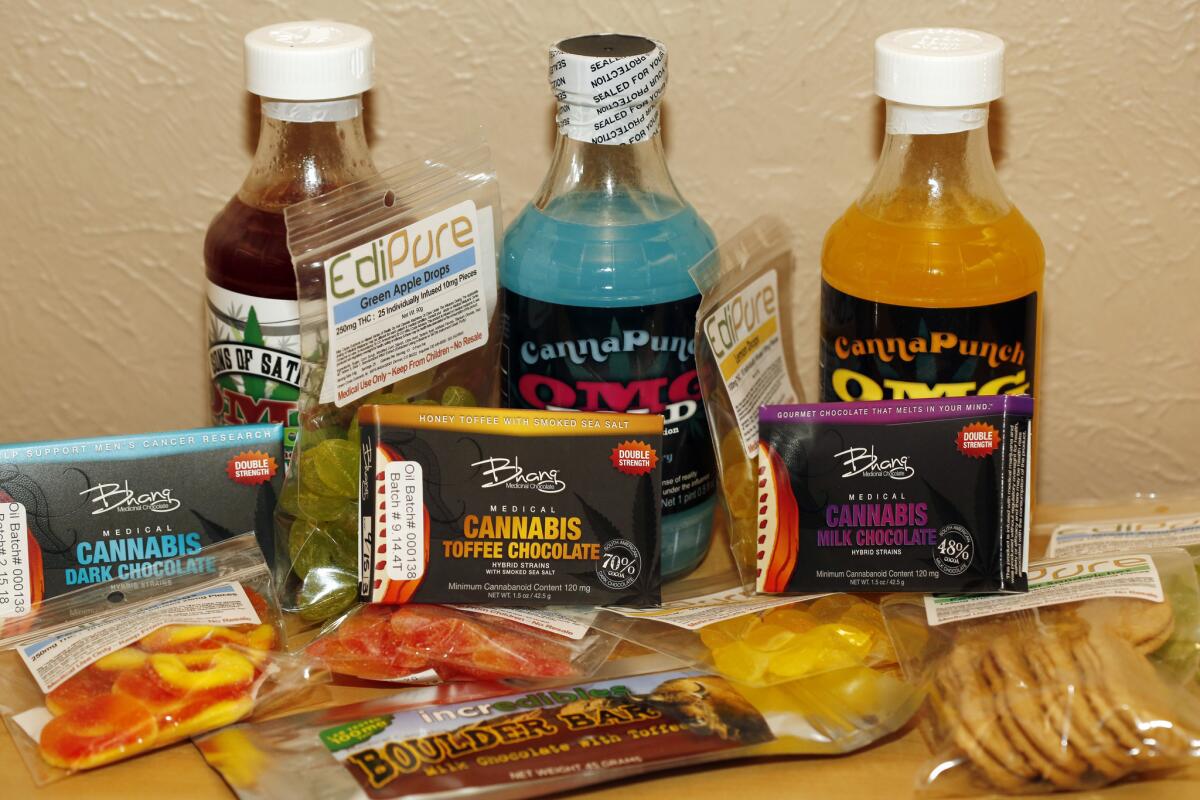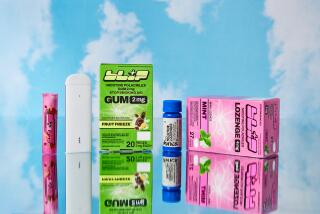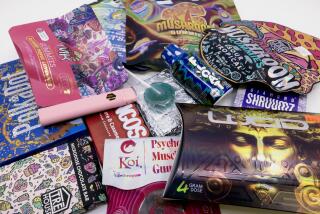Op-Ed: We need to start child-proofing pot

In states where medical and recreational cannabis sales are allowed, disquieting new trends and statistics are proving its unique dangers for those most vulnerable to its effects: children.
One such statistic is a spike in calls to poison control centers. According to the National Poison Data System, calls about accidental ingestion of marijuana in children 9 and younger more than tripled in states that decriminalized marijuana before 2005. In states that enacted legalization from 2005 to 2011, calls increased nearly 11.5% per year. Over the same period in states without decriminalization laws, the call rate stayed the same. In the decriminalized states, such calls were also more likely to result in critical-care admissions. Neurological effects were the most common.
These findings led the studyâs authors to recommend warning labels and child-resistant packaging, especially for edible marijuana products that resemble candy.
Candy? Yes, in medical dispensaries, marijuana-infused fudge, gelato, gummi candies and hard candies are just a few of the offerings. And remember, the pot used in a 1970s-era brownie was a lot less potent than todayâs pot, which in some samples has been found to have triple the amount of THC, its psychoactive ingredient, compared with 50 years ago.
A University of Colorado study blamed the proliferation of these drug-laced edibles, combined with relaxed marijuana laws, for a surge in emergency room visits by children who had accidentally ingested marijuana. âBefore the marijuana boom these kinds of edibles were not mass-produced and the amount of THC ingested was somewhat limited,â said Dr. George Wang, lead study author, upon the reportâs release. âBut now we are seeing much higher strength marijuana.â
Increased legalization also means easier access for adolescents. In a study of Colorado teens in substance-abuse treatment centers, for example, 74% said they had gotten marijuana from someone who qualified for it medically. Researchers call it diversion.
Legalization may also be encouraging more kids to consider trying marijuana. In a recent study of thousands of high school seniors, 10% of nonusers said they would try marijuana if the drug were legal in their state. This included large subgroups of students normally at low risk, including non-cigarette smokers, those with strong religious affiliations and those with friends who disapprove of drugs. And of the students already using marijuana? Eighteen percent said they would use more under legalization.
Whatever is intended by legalization, children seem to be hearing this: Marijuana is no big deal. But especially for the young, nothing could be further from the truth. Hereâs a review of marijuanaâs negative effects on developing brains and bodies:
⢠Marijuana damages developing brains. Adolescence is a particularly vulnerable time for the brain, which continues developing well into the 20s. Marijuana can disrupt the process, meaning the brain may not form normally. At particular risk are chronic users. One study found that teens who smoked marijuana daily for about three years performed poorly on memory tasks â and this was two years after they had stopped use. Memory-related structures in the brain appeared to shrink and collapse inward, and the younger the smokers were when they began chronic use, the more abnormally the brain regions were shaped.
⢠Marijuana is linked to mental health problems. The National Institute on Drug Abuse warns that there are now âsufficient dataâ to show that for those predisposed to schizophrenia, marijuana may trigger its onset and possibly intensify the symptoms. It has also been linked to increased depression and suicidal thoughts.
⢠Marijuana sets up kids for failure. We give children one overriding task: to learn. Introducing a substance that slows reaction time, distorts judgment and interferes with memory short-circuits that task. In addition, the younger kids are when they try marijuana, the more likely they are to become addicted (yes, marijuana can be addictive) and the more likely they are to go on to use other drugs. One analysis by Columbia University researchers found that teens who had used marijuana at least once in the previous 30 days were almost 26 times more likely than those who never used marijuana to try other drugs such as cocaine, heroin, methamphetamines, LSD or Ecstasy.
It may be too late to stem the rush toward legalization of recreational marijuana use and the proliferation of products that comes with it. Instead, we need to focus on better ways to protect children, combat the notion that marijuana is harmless and fund the much-needed additional research on medical uses for marijuanaâs chemical components, such as the promising cannabidiol, which may prove effective without producing a high. Controlled scientific studies, after all, should be deciding marijuanaâs potential legitimacy as a medicine.
Legal or not, for the most vulnerable among us â our kids â marijuana is the opposite of no big deal.
Dr. David Sack is board certified in psychiatry, addiction psychiatry and addiction medicine. He is chief executive of Elements Behavioral Health, a network of mental health and addiction treatment centers that includes adolescent and young adult rehab programs.
More to Read
A cure for the common opinion
Get thought-provoking perspectives with our weekly newsletter.
You may occasionally receive promotional content from the Los Angeles Times.










